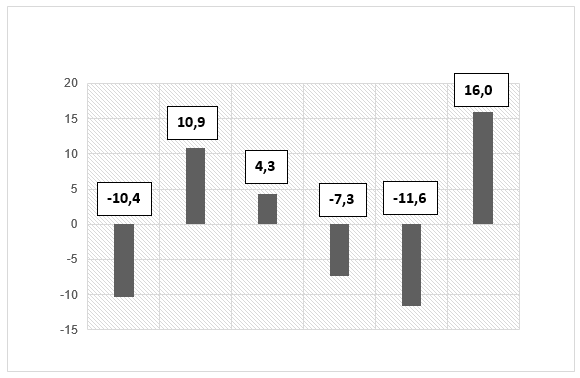Approach to the Spanish Forestry sector
Main Article Content
Abstract
Downloads
Article Details
References
AEDO, C., DIEGO, C., GARCÍA CODRON, J.C. y MORENO, G., 1990. El bosque en Cantabria [en línea]. España: Universidad de Cantabria. ISBN 978-84-87412-16-5. Disponible en: https://books.google.com.cu/books?id=Qh3r1ZEyWscC&printsec=frontcover&hl=es&source=gbs_ge_summary_r&cad=0#v=onepage&q&f=false.
ANAYA ROMERO, M., MUÑOZ ROJAS, M., IBÁÑEZ MORENO, B. y MARAÑÓN, T., 2016. Evaluation of forest ecosystem services in Mediterranean areas. A regional case study in South Spain. Ecosystem Services [en línea], vol. 20, pp. 8290. [Consulta: 17 marzo 2020]. ISSN 2212-0416. DOI 10.1016/j.ecoser.2016.07.002. Disponible en: https://digital.csic.es/handle/10261/135309.
ARAGÓN RUANO, Á., 2011. La historiografía forestal sobre época moderna en el panorama internacional, español y vasco: una revisión bibliográfica. Vasconia, Cuadernos de Historia-Geografía [en línea], vol. 37, pp. 117-140. [Consulta: 17 marzo 2020]. ISSN 1136-6834. DOI http://hdl.handle.net/10810/8935. Disponible en: https://addi.ehu.es/handle/10810/8935.
BASTIDA, M., VAQUERO GARCÍA, A., CANCELO MÁRQUEZ, M. y OLVEIRA BLANCO, A., 2020. Fostering the Sustainable Development Goals from an Ecosystem Conducive to the SE: The Galician's Case. Sustainability [en línea], vol. 12, no. 2, pp. 500. [Consulta: 17 marzo 2020]. DOI 10.3390/su12020500. Disponible en: https://www.mdpi.com/2071-1050/12/2/500.
CUEVAS, A. B., 2001. Los recursos forestales en APEC, una visión ambiental y económica. México y la Cuenca del Pacífico [en línea],no. 14, pp.55-61.[Consulta: 17 marzo 2020]. https://doi.org/10.32870/mycp.v4i14.148.
DEMARÍA CASTAÑEDA, I., TINOCO PASTOR, M.P. y MORENO PÉREZ, R., 2014. Los montes como generadores de empleo. Tecnología y desarrollo [en línea], vol. 12, no. 0, pp. 17. [Consulta: 17 marzo 2020]. ISSN 1696-8085. Disponible en: https://revistas.uax.es/index.php/tec_des/article/view/592.
DÍAZ BALTEIRO, L., 2008. Caracterización de la industria forestal en España: aspectos económicos y ambientales [en línea]. S.l.: Fundación BBVA. [Consulta: 17 marzo 2020]. ISBN 978-84-96515-78-9. Disponible en: https://dialnet.unirioja.es/servlet/libro?codigo=355071.
DÍAZ BALTEIRO, L., GONZÁLEZ PACHÓN, J. y ROMERO, C., 2017. Measuring systems sustainability with multi-criteria methods: A critical review. European Journal of Operational Research [en línea], vol. 258, no. 2, pp. 607-616. [Consulta: 17 marzo 2020]. ISSN 0377-2217. DOI 10.1016/j.ejor.2016.08.075. Disponible en: http://www.sciencedirect.com/science/article/pii/S0377221716307147.
EZQUERRO, M., PARDOS, M. y DÍAZ BALTEIRO, L., 2019. Integrating variable retention systems into strategic forest management to deal with conservation biodiversity objectives. Forest Ecology and Management [en línea], vol. 433, pp. 585-593. [Consulta: 17 marzo 2020]. ISSN 0378-1127. DOI 10.1016/j.foreco.2018.11.003. Disponible en: http://www.sciencedirect.com/science/article/pii/S0378112718310077.
FAO, 1978. Desarrollo Forestal Comunitario [en línea]. 1978. S.l.: FAO. Disponible en: http://www.fao.org/3/u5610s/u5610s04.htm.
GÓMEZ MENDOZA, J. y MATA OLMO, R., 1992. Actuaciones forestales públicas desde 1940. Objetivos, criterios y resultados. Agricultura y sociedad [en línea], vol. 65, pp. 15-64. ISSN 0211-8394. Disponible en: https://www.researchgate.net/publication/28144579_Actuaciones_forestales_publicas_desde_1940_Objetivos_criterios_y_resultados.
GROOME, H., 1990. Historia de la política forestal en el estado español [en línea]. Madrid: Agencia de Medio Ambiente, D.L. [Consulta: 17 marzo 2020]. ISBN 978-84-451-0180-3. Disponible en: https://dialnet.unirioja.es/servlet/libro?codigo=76179.
HERRERA, A. 1980. Labradores, ganaderos y aprovechamientos comunales. Algunos aspectos de su conflictividad en las tierras sevillanas durante el Antiguo Régimen. En: Agricultura y Sociedad, nº17, pp.255-291.
IRIARTE GOÑI, I., 2009. La obra de Octavio Elorrieta (1881-1962): el monte al servicio de la economía. Historia agraria: Revista de agricultura e historia rural [en línea], no. 48, pp. 133-159. [Consulta: 17 marzo 2020]. ISSN 1139-1472. Disponible en: https://dialnet.unirioja.es/servlet/articulo?codigo=3026797.
JIMÉNEZ GONZÁLEZ, A., PINCAY ALCIVAR, F.A., RAMOS RODRÍGUEZ, M.P., MERO JALCA, O.F. y CABRERA VERDESOTO, C.A., 2017. Utilización de productos forestales no madereros por pobladores que conviven en el bosque seco tropical. Revista Cubana de Ciencias Forestales [en línea], vol. 5, no. 3, pp. 270-286. [Consulta: 17 marzo 2020]. ISSN 2310-3469. Disponible en: http://cfores.upr.edu.cu/index.php/cfores/article/view/264.
MARTÍNEZ DE ARANO, I., PALAHÍ LOZANO, M., FARCY, C., ROJAS, E. y HETEMAKI, L., 2018. Perspectivas de una bioeconomía forestal en el Mediterráneo. Mediterráneo económico [en línea], no. 31, pp. 63-93. [Consulta: 17 marzo 2020]. ISSN 1698-3726. Disponible en: https://dialnet.unirioja.es/servlet/articulo?codigo=6648770.
MARTÍNEZ NUÑEZ, M. y DÍAZ BALTEIRO, L., 2007. La industria forestal en España. Aspectos productivos, organizativos y medioambientales. Forest Systems [en línea], vol. 16, no. 2, pp. 182-196. ISSN 1131-7965. Disponible en: https://www.researchgate.net/publication/28251754_La_industria_forestal_en_Espana_Aspectos_productivos_organizativos_y_medioambientales.
MENA FRAU, C., GAJARDO VALENZUELA, J., ORMAZÁBALROJAS, Y., MORALES HERNÁNDEZ, Y. y MONTECINOS GUAJARDO, R., 2006. Teledetección y Sig en el Ámbito Forestal: Experiencias en Chile Remote Sensing and Gis in Forestry: Experiences in Chile. AMBIENCIA [en línea], vol. 2, no. 3, pp. 171-185. [Consulta: 17 marzo 2020]. ISSN 2175-9405. Disponible en: https://revistas.unicentro.br/index.php/ambiencia/article/view/265.
MINISTERIO DE AGRICULTURA, ALIMENTACIÓN Y MEDIO AMBIENTE, 2014. Diagnóstico del Sector Forestal Español. Análisis y Prospectiva [en línea], no. 8. Disponible en: https://www.mapa.gob.es/es/ministerio/servicios/analisis-y-prospectiva /AyP_serie%20n%C2%BA8%20diagn%C3%B3stico%20sector%20FORESTAL_tcm30-88409.pdf.
ORTUÑO PÉREZ, S., 2012. Estructura económica del sector forestal en España. Quebracho (Santiago del Estero) [en línea], vol. 20, pp. 49-59. Disponible en: https://www.researchgate.net/publication/262665190_Estructura_economica_del_sector_forestal_en_Espana.
PEMÁN, J., 2019. Reflexiones sobre algunos de los condicionantes actuales de la educación forestal universitaria. Montes: Revista de Ámbito Forestal [en línea], vol. 135. Disponible en: https://www.revistamontes.net/UltimosNumeros.aspx?num=135.
RAMOS GOROSTIZA, J.L., 2006. Gestión ambiental y política de conservación de la naturaleza en la España de Franco. Revista de Historia Industrial [en línea], no. 32, pp. 99-140. [Consulta: 17 marzo 2020]. ISSN 1132-7200. Disponible en: https://dialnet.unirioja.es/servlet/articulo?codigo=2262368.
SERRADA HIERRO, RAFAEL, 1995. Apuntes de Repoblaciones Forestales [en línea]. España: Fundación Conde del Valle de Salazar. [Consulta: 17 marzo 2020]. ISBN 978-84-86793-34-0. Disponible en: https://www.todostuslibros.com/libros/apuntes-de-repoblaciones-forestales_978 -84-86793-34-0.
ZAIMES, G.N., GARCÍA RODRÍGUEZ, J.L., IAKOVOGLOU, V. y EMMANOULOUDIS, D.A., 2019. Conservación de los ecosistemas riparios y deltaicos y mejora de las oportunidades de ecoturismo. Cuadernos de la Sociedad Española de Ciencias Forestales [en línea], no. 45, pp. 145-156. [Consulta: 17 marzo 2020]. ISSN 1575-2410, 2386-8368. Disponible en: https://dialnet.unirioja.es/servlet/articulo?codigo=6946694.


